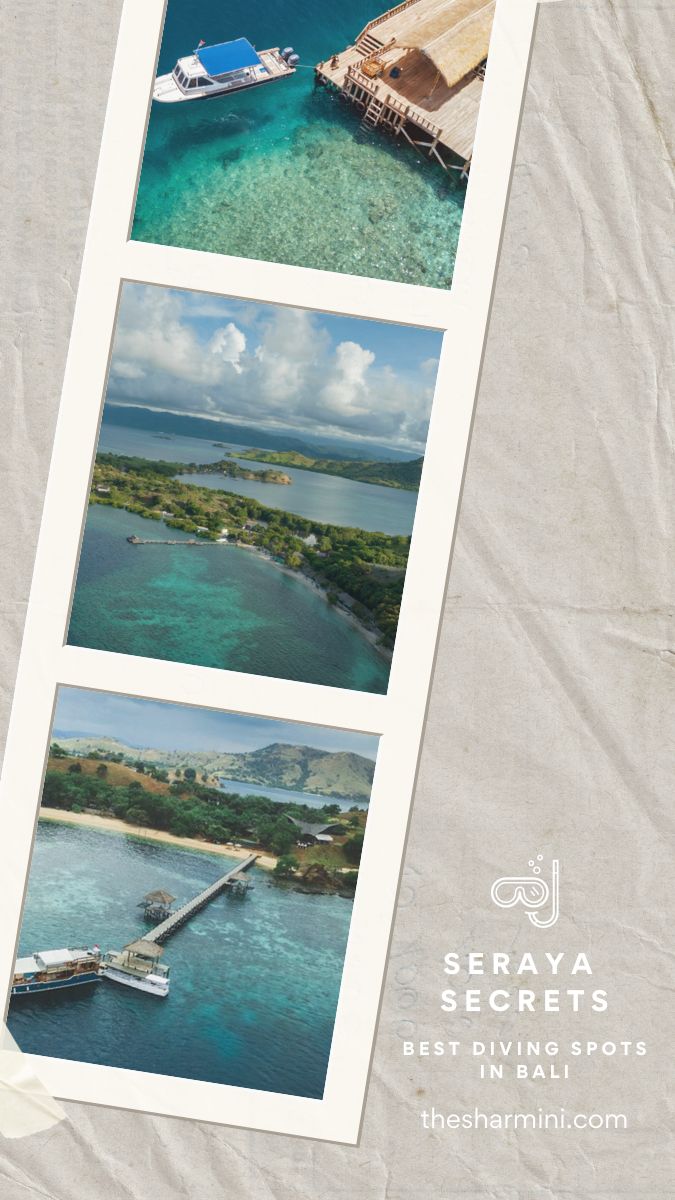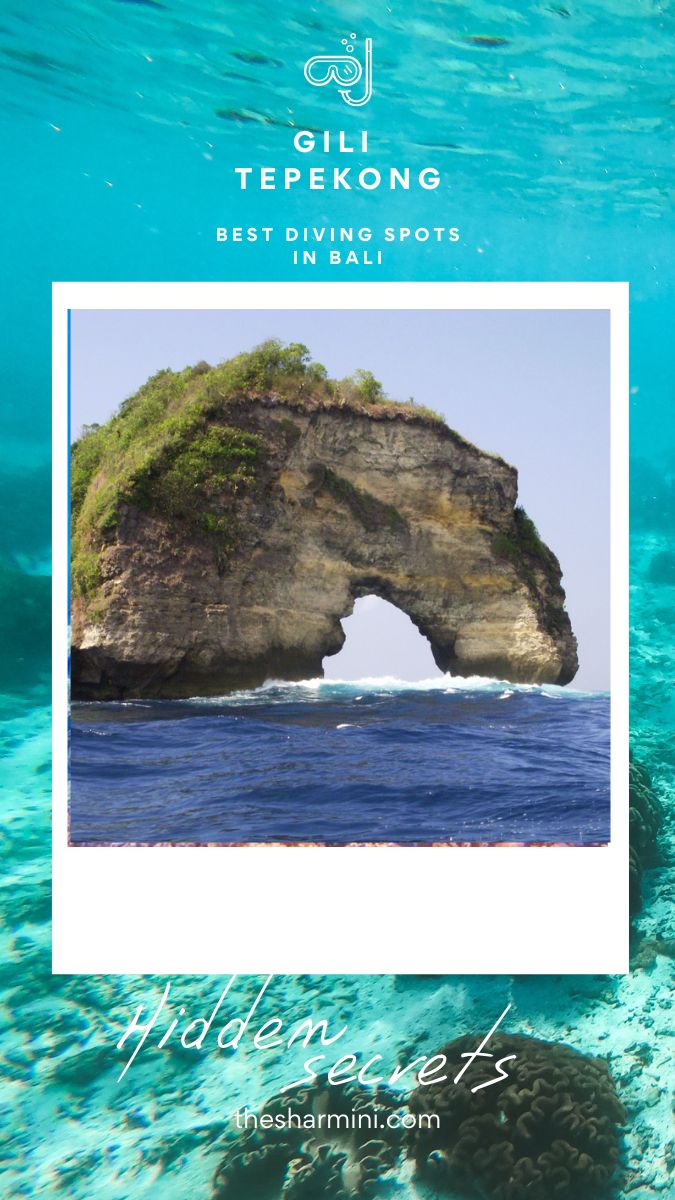Looking for the best diving in Bali? I’ll get to it. But first…let’s address the elephant in the room – safety. Diving in Bali is undoubtedly a safe adventure for solo travelers, but like any thrilling activity, use common sense and exercise caution..

Keep your gear secure, follow your dive leader’s instructions, and always remember the buddy system. Y’all know the drill.
So, let’s dive (no pun intended) into these tips, each seeped with a splash of local flavor.
Best Diving in Bali – 10 Must Hit Spots

Menjangan Island
Known for: Dramatic wall dives; Menjangan Island offers pristine coral gardens and a diverse marine life.
Type of Dive: Wall diving.
Maximum Depth: Up to 40 meters.
Level: Suitable for all levels.
Best Season: April to November.

Seraya Secrets
Known for: A haven for macro photography enthusiasts, featuring unique muck diving experiences.
Type of Dive: Muck diving.
Maximum Depth: Around 25 meters.
Level: Intermediate to Advanced.
Best Season: Year-round.

USAT Liberty Wreck, Tulamben
Description: A historic World War II shipwreck, home to a vibrant ecosystem.
Type of Dive: Wreck diving.
Maximum Depth: 30 meters.
Level: All levels, including beginners.
Best Season: Year-round, with the best visibility from April to July.

Amed
Description: Offers a peaceful diving experience with beautiful coral reefs and an abundance of fish.
Type of Dive: Reef diving.
Maximum Depth: 30 meters.
Level: All levels.
Best Season: May to November.

Manta Point – Nusa Penida
Description: Famous for its manta ray sightings, offering an unforgettable experience.
Type of Dive: Drift diving.
Maximum Depth: Up to 30 meters.
Level: Intermediate.
Best Season: April to May.
Crystal Bay – Nusa Penida
Description: Known for its crystal-clear waters and a chance to see the rare mola-mola.
Type of Dive: Wall and drift diving.
Maximum Depth: Up to 40 meters.
Level: Advanced due to strong currents.
Best Season: August to October.

Padang Bai
Description: This small coastal town offers diverse dive sites with vibrant marine life and coral gardens.
Type of Dive: Reef and muck diving.
Maximum Depth: 30 meters.
Level: Beginners to Advanced.
Best Season: Year-round.

Gili Tepekong
Description: Known for its challenging conditions and strong currents, it’s a haven for adrenaline-seeking divers.
Type of Dive: Drift and canyon diving.
Maximum Depth: Up to 40 meters.
Level: Advanced.
Best Season: May to November.

Pemuteran
Description: Famous for its bio-rock coral restoration project, Pemuteran offers a unique dive experience.
Type of Dive: Artificial reef and macro diving.
Maximum Depth: 30 meters.
Level: All levels.
Best Season: April to December.

Secret Bay, Gilimanuk
Description: Ideal for muck diving enthusiasts, this bay is known for its rare and unusual critters.
Type of Dive: Muck diving.
Maximum Depth: 12 meters.
Level: Beginner to Intermediate.
Best Season: Year-round.

Diving Safety and Best Practices
Safety is paramount in diving, and adhering to best practices ensures an enjoyable and risk-minimized experience. Here are some essential guidelines:
Get Proper Training: Always dive within the limits of your training and certification. Beginners should ALWAYS start with basic courses.
Health Checks: Ensure you are medically fit to dive. Regular health check-ups and staying hydrated are crucial.
Know Your Equipment: Familiarize yourself with all diving gear. Regular maintenance and pre-dive checks are essential. Not super sure what you’re doing? Take a refresher course.
Dive Planning: Plan your dive and dive your plan. Be aware of dive site conditions, currents, and weather forecasts.
Buddy System: Never dive alone. The buddy system is these for a reason.
Conservation Awareness: Be a responsible diver. Avoid touching or disturbing marine life and coral reefs. Understand and respect local conservation efforts.
Emergency Preparedness: Know the basics of first aid and emergency response. Have a plan for dealing with potential diving emergencies. Keep calm and don’t panic.
Respect Depth and Time Limits: Adhere to depth and time limits to avoid decompression sickness.
Surface Safely: Ascend slowly and perform safety stops as recommended.
Stay Within Your Comfort Zone: Don’t succumb to peer pressure. If a dive feels beyond your skill level, it’s okay to opt out.
Heading to Bali? Check out the best spots to stay for first timers, or how to travel safely through Bali as a solo female.
Diving Courses and Certification in Bali
Bali is replete with reputable dive schools offering a range of certification courses. These include:
PADI Open Water Diver: Ideal for beginners, focusing on fundamentals of scuba diving.
Advanced Open Water Diver: For divers seeking to expand their skills and dive deeper.
Specialty Courses: Encompassing areas like underwater photography, deep diving, and night diving.
Rescue Diver and First Aid: Emphasizing safety and emergency response skills.
Divemaster and Instructor Courses: For those looking to turn their passion into a profession.
These schools often provide comprehensive packages, including equipment rental, course materials, and practical dive experiences.
The certification process typically involves theoretical learning, confined water training, and open water dives.

Seasonal Variations and Weather Conditions for Diving in Bali
The best times to dive in Bali largely depend on the specific dive site and weather conditions:
Dry Season (April to October): Offers the best overall conditions for diving with clearer waters and calm seas. Ideal for most dive sites.
Wet Season (November to March): Can bring reduced visibility and rougher seas, but also opportunities for different marine life sightings.
Do’s and Don’ts:
- Do check local weather and sea conditions before planning your dive.
- Do consider the monsoon season as it can impact visibility and accessibility to some dive sites.
- Do plan your dive according to the season, as some sites are best during specific months.
- Don’t underestimate the power of currents; always dive with a knowledgeable guide, especially in challenging sites.
- Don’t ignore local advice about weather-related safety concerns.

Underwater Photography Tips
Capturing Bali’s underwater world requires both technique and the right equipment:
Use a Good Underwater Camera: Choose a camera suited for underwater photography, considering factors like depth rating and lighting options.
Learn Basic Photography Skills: Understand composition, lighting, and camera settings for clear, vibrant photos.
Get Close, But Respect Marine Life: Close-ups reveal fascinating details, but avoid disturbing the habitat.
Use Natural Light When Possible: For shallow dives, natural light can beautifully illuminate your subject.
Stabilize Your Shots: Steady hands or a tripod can prevent blurry images in moving waters.
Practice Responsible Photography: Never harm or stress marine creatures for a photo.
Here are products that range from user-friendly options for beginners to more advanced setups for professional quality underwater photography.

GoPro HERO9 Black
The GoPro HERO9 Black is an action camera known for its rugged design and ability to capture high-quality images and videos underwater. It’s compact, user-friendly, and has excellent stabilization features.

Canon EOS 5D Mark IV with Ikelite Underwater Housing
This DSLR camera setup is ideal for professional underwater photography. The Canon EOS 5D Mark IV delivers high-resolution images, and the Ikelite housing ensures durability and functionality deep underwater.

SeaLife Micro 3.0
Specifically designed for underwater photography, this compact camera is easy to use, with features like 4K video and 16MP images, suitable for beginners and experienced divers.

Olympus Tough TG-6
A robust, waterproof compact camera perfect for snorkeling and casual diving. It offers impressive macro capabilities, 4K video recording, and is shock, freeze, and crush-proof.

Sony RX100 VII with Fantasea Underwater Housing
Combining Sony’s advanced compact camera with Fantasea’s custom housing creates a high-quality, versatile underwater photography setup, known for its excellent image quality and compact design.
Local Culture and Attractions
Bali isn’t just about its underwater allure; it’s a cultural treasure trove on land.
From the spiritual serenity of Uluwatu Temple to the vibrant traditional dances in Ubud, each experience enriches your journey. Explore the lush terraced rice fields of Tegallalang, or unwind on the serene beaches of Seminyak.
Don’t miss out on the local cuisine – a delightful exploration of flavors at a Balinese warung is a must.
Every corner of Bali offers a slice of its rich heritage, ensuring your surface intervals are as captivating as your dives.
“For those traveling with family, intertwining diving with family-friendly activities is key. ‘Best Family Resorts in Bali’ offers excellent stay options.”
Travel and Accommodation Tips
For divers visiting Bali, consider staying in areas like Tulamben or Amed for easy access to prime dive sites.
Opt for dive resorts or guest houses that cater to divers, offering gear storage and early breakfasts. Always check for transport availability to and from dive locations.
For a more immersive experience, explore accommodation options in cultural hubs like Ubud or beach areas like Canggu and Uluwatu.
Budget-friendly hostels, luxurious resorts, and private villas are available to suit various preferences. Don’t forget to arrange transportation for remote dive sites!
Conservation Efforts and Marine Life Protection
Bali is at the forefront of marine conservation, with initiatives like coral restoration projects and plastic reduction campaigns.
Divers are encouraged to engage in eco-friendly practices, such as not touching marine life, avoiding coral damage, and participating in local clean-up dives.
Educate yourself on the local marine ecosystem, support conservation-focused dive operators, and consider contributing to local NGOs.
Responsible diving in Bali not only enhances your experience but also helps preserve its marine environment for future generations.

Hot Tip: When diving in Bali, always carry a reef-safe sunscreen. Protecting your skin is crucial, but it’s equally important to protect the coral reefs from harmful chemicals. Reef-safe sunscreens are biodegradable and lack substances like oxybenzone, which can damage marine ecosystems. This small step makes a big difference in preserving Bali’s stunning underwater world.
FAQs Section
Q1: Do I need to be certified to dive in Bali?
Yes, a basic Open Water certification is required for most dives. Beginners can enroll in courses in Bali.
Q2: What’s the best time of year to dive in Bali?
April to October offers the best conditions, but diving is great year-round.
Q3: Are there any health requirements for diving?
A basic fitness level and no major health issues. Always consult with a dive professional.
Q4: Can beginners dive in Bali?
Absolutely! Bali offers many sites suitable for beginners.
Q5: Is it safe to dive alone in Bali?
Diving should always be done with a buddy, especially in unfamiliar waters.
Q6: What marine life can I expect to see?
Manta rays, sharks, turtles, and a vibrant array of fish and coral species.
Q7: Do I need my own equipment?
Not necessary, as dive centers provide rental equipment.
Q8: What are the conservation guidelines for divers?
Avoid touching marine life, stay clear of corals, and follow all local conservation rules.




